Theoretical Investigation of Nanocomposites: Materials Science Report
VerifiedAdded on 2019/11/26
|36
|8875
|256
Report
AI Summary
This report provides a comprehensive theoretical investigation of nanocomposites, particularly focusing on polymer hydrogels and their reinforcement with nanoparticles like silica. It explores the unique properties of these materials, including their ability to absorb large quantities of water, their mechanical strength, and their sensitivity to various stimuli such as pH, temperature, and electric fields. The report delves into the structural properties of hydrogels, the impact of nanocomposites on their thermal and mechanical behaviors, and their applications in fields like drug delivery and medical chemistry. It highlights the synergistic effects of combining hydrogels with nanoparticles, leading to enhanced functionalities and diverse applications. Furthermore, the report discusses the significance of stimuli-responsive systems and the importance of understanding the relationship between the material's composition, structure, and properties for various practical applications. The study also emphasizes the importance of understanding how factors like nanoparticle concentration influence the behavior of hydrogels, including their ability to swell and deswell in response to different stimuli, and how the material's properties are affected by various variables.
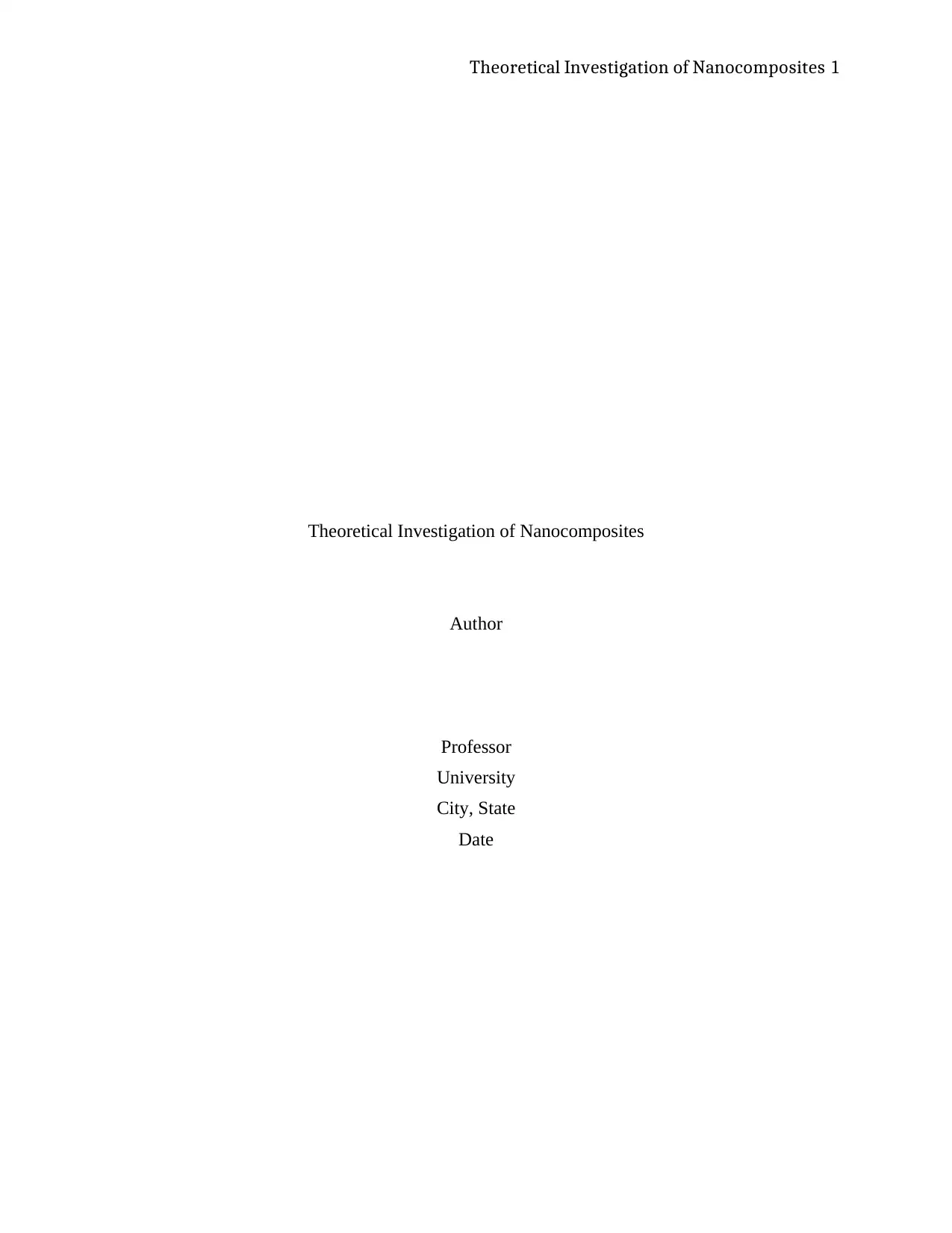
Theoretical Investigation of Nanocomposites 1
Theoretical Investigation of Nanocomposites
Author
Professor
University
City, State
Date
Theoretical Investigation of Nanocomposites
Author
Professor
University
City, State
Date
Paraphrase This Document
Need a fresh take? Get an instant paraphrase of this document with our AI Paraphraser
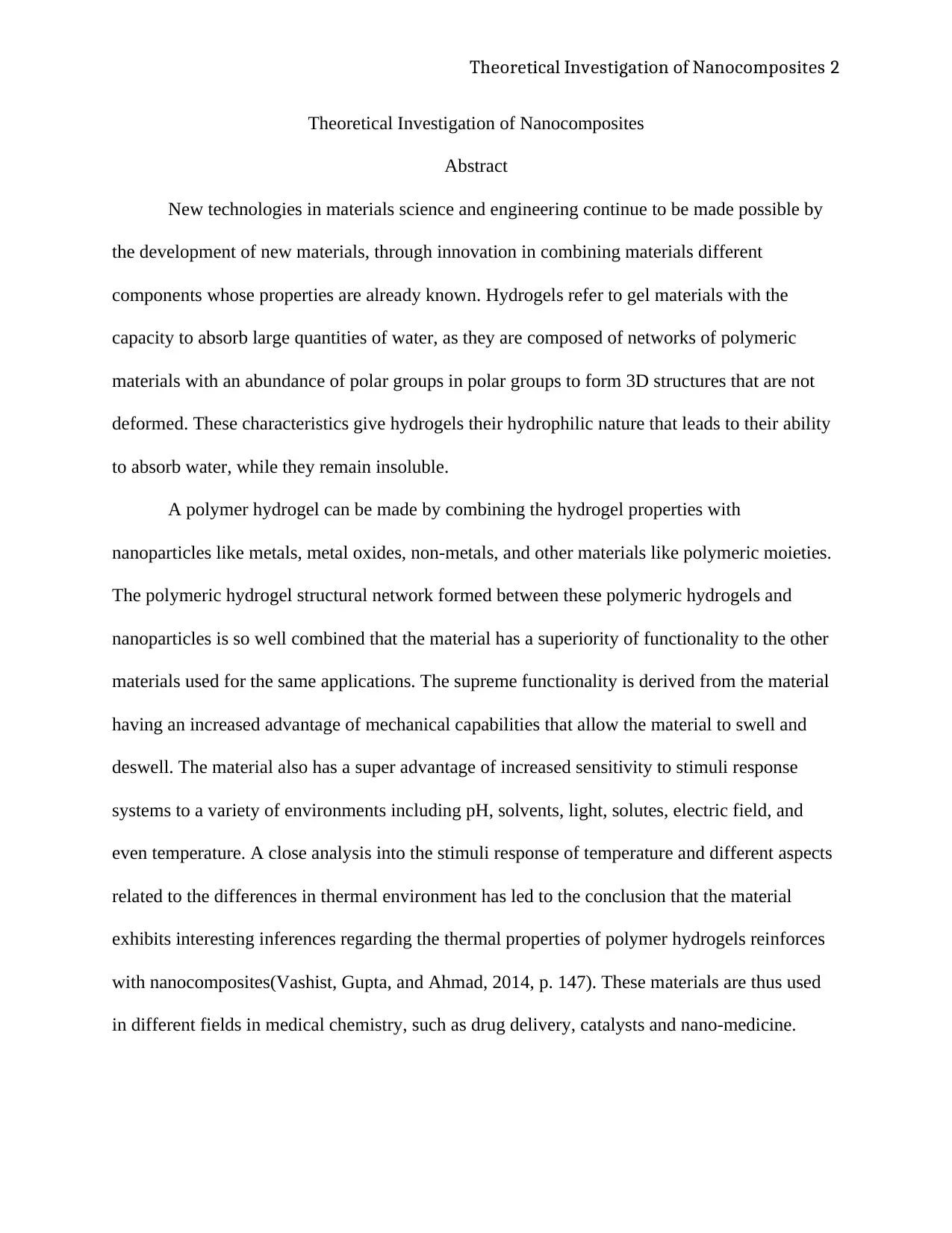
Theoretical Investigation of Nanocomposites 2
Theoretical Investigation of Nanocomposites
Abstract
New technologies in materials science and engineering continue to be made possible by
the development of new materials, through innovation in combining materials different
components whose properties are already known. Hydrogels refer to gel materials with the
capacity to absorb large quantities of water, as they are composed of networks of polymeric
materials with an abundance of polar groups in polar groups to form 3D structures that are not
deformed. These characteristics give hydrogels their hydrophilic nature that leads to their ability
to absorb water, while they remain insoluble.
A polymer hydrogel can be made by combining the hydrogel properties with
nanoparticles like metals, metal oxides, non-metals, and other materials like polymeric moieties.
The polymeric hydrogel structural network formed between these polymeric hydrogels and
nanoparticles is so well combined that the material has a superiority of functionality to the other
materials used for the same applications. The supreme functionality is derived from the material
having an increased advantage of mechanical capabilities that allow the material to swell and
deswell. The material also has a super advantage of increased sensitivity to stimuli response
systems to a variety of environments including pH, solvents, light, solutes, electric field, and
even temperature. A close analysis into the stimuli response of temperature and different aspects
related to the differences in thermal environment has led to the conclusion that the material
exhibits interesting inferences regarding the thermal properties of polymer hydrogels reinforces
with nanocomposites(Vashist, Gupta, and Ahmad, 2014, p. 147). These materials are thus used
in different fields in medical chemistry, such as drug delivery, catalysts and nano-medicine.
Theoretical Investigation of Nanocomposites
Abstract
New technologies in materials science and engineering continue to be made possible by
the development of new materials, through innovation in combining materials different
components whose properties are already known. Hydrogels refer to gel materials with the
capacity to absorb large quantities of water, as they are composed of networks of polymeric
materials with an abundance of polar groups in polar groups to form 3D structures that are not
deformed. These characteristics give hydrogels their hydrophilic nature that leads to their ability
to absorb water, while they remain insoluble.
A polymer hydrogel can be made by combining the hydrogel properties with
nanoparticles like metals, metal oxides, non-metals, and other materials like polymeric moieties.
The polymeric hydrogel structural network formed between these polymeric hydrogels and
nanoparticles is so well combined that the material has a superiority of functionality to the other
materials used for the same applications. The supreme functionality is derived from the material
having an increased advantage of mechanical capabilities that allow the material to swell and
deswell. The material also has a super advantage of increased sensitivity to stimuli response
systems to a variety of environments including pH, solvents, light, solutes, electric field, and
even temperature. A close analysis into the stimuli response of temperature and different aspects
related to the differences in thermal environment has led to the conclusion that the material
exhibits interesting inferences regarding the thermal properties of polymer hydrogels reinforces
with nanocomposites(Vashist, Gupta, and Ahmad, 2014, p. 147). These materials are thus used
in different fields in medical chemistry, such as drug delivery, catalysts and nano-medicine.
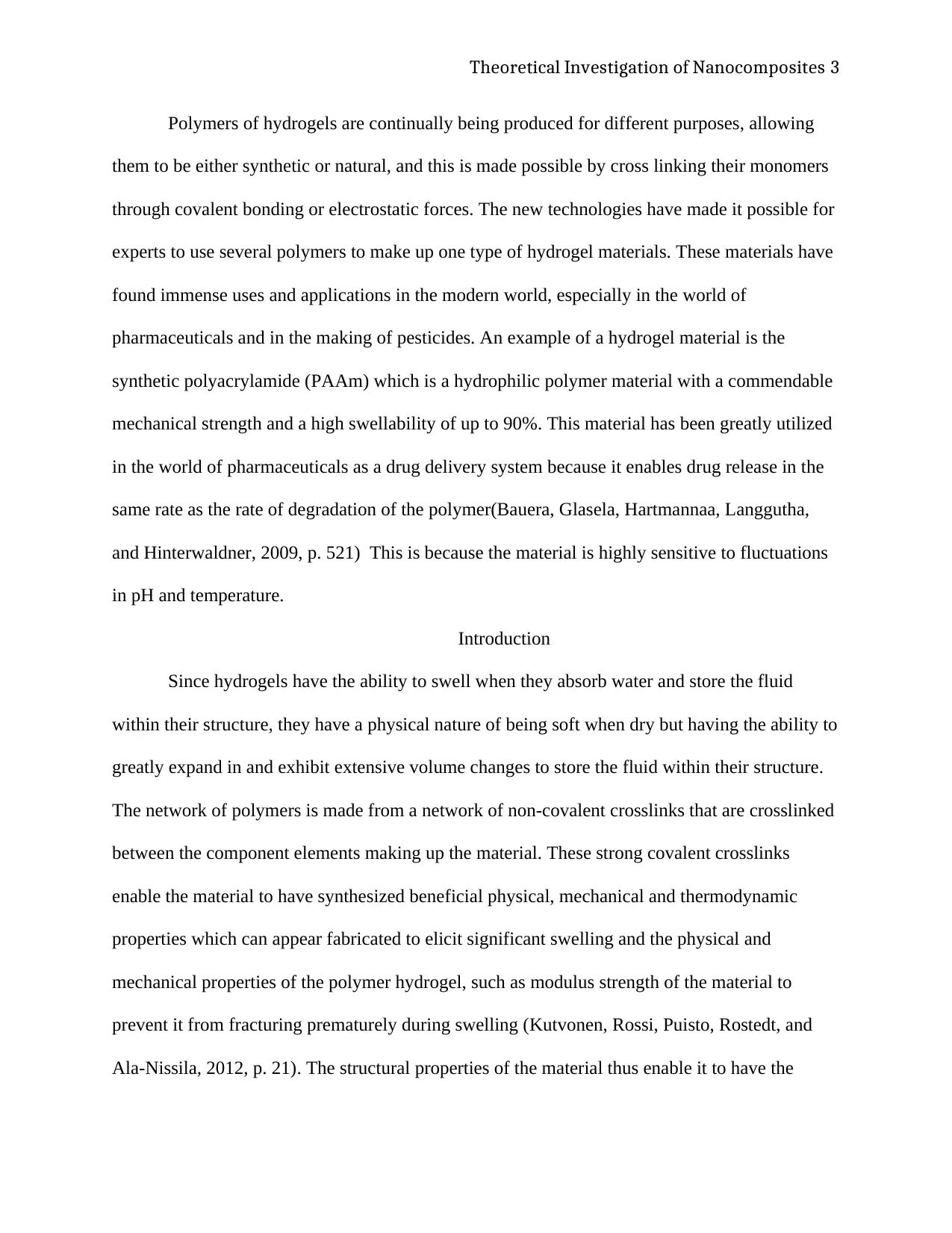
Theoretical Investigation of Nanocomposites 3
Polymers of hydrogels are continually being produced for different purposes, allowing
them to be either synthetic or natural, and this is made possible by cross linking their monomers
through covalent bonding or electrostatic forces. The new technologies have made it possible for
experts to use several polymers to make up one type of hydrogel materials. These materials have
found immense uses and applications in the modern world, especially in the world of
pharmaceuticals and in the making of pesticides. An example of a hydrogel material is the
synthetic polyacrylamide (PAAm) which is a hydrophilic polymer material with a commendable
mechanical strength and a high swellability of up to 90%. This material has been greatly utilized
in the world of pharmaceuticals as a drug delivery system because it enables drug release in the
same rate as the rate of degradation of the polymer(Bauera, Glasela, Hartmannaa, Langgutha,
and Hinterwaldner, 2009, p. 521) This is because the material is highly sensitive to fluctuations
in pH and temperature.
Introduction
Since hydrogels have the ability to swell when they absorb water and store the fluid
within their structure, they have a physical nature of being soft when dry but having the ability to
greatly expand in and exhibit extensive volume changes to store the fluid within their structure.
The network of polymers is made from a network of non-covalent crosslinks that are crosslinked
between the component elements making up the material. These strong covalent crosslinks
enable the material to have synthesized beneficial physical, mechanical and thermodynamic
properties which can appear fabricated to elicit significant swelling and the physical and
mechanical properties of the polymer hydrogel, such as modulus strength of the material to
prevent it from fracturing prematurely during swelling (Kutvonen, Rossi, Puisto, Rostedt, and
Ala-Nissila, 2012, p. 21). The structural properties of the material thus enable it to have the
Polymers of hydrogels are continually being produced for different purposes, allowing
them to be either synthetic or natural, and this is made possible by cross linking their monomers
through covalent bonding or electrostatic forces. The new technologies have made it possible for
experts to use several polymers to make up one type of hydrogel materials. These materials have
found immense uses and applications in the modern world, especially in the world of
pharmaceuticals and in the making of pesticides. An example of a hydrogel material is the
synthetic polyacrylamide (PAAm) which is a hydrophilic polymer material with a commendable
mechanical strength and a high swellability of up to 90%. This material has been greatly utilized
in the world of pharmaceuticals as a drug delivery system because it enables drug release in the
same rate as the rate of degradation of the polymer(Bauera, Glasela, Hartmannaa, Langgutha,
and Hinterwaldner, 2009, p. 521) This is because the material is highly sensitive to fluctuations
in pH and temperature.
Introduction
Since hydrogels have the ability to swell when they absorb water and store the fluid
within their structure, they have a physical nature of being soft when dry but having the ability to
greatly expand in and exhibit extensive volume changes to store the fluid within their structure.
The network of polymers is made from a network of non-covalent crosslinks that are crosslinked
between the component elements making up the material. These strong covalent crosslinks
enable the material to have synthesized beneficial physical, mechanical and thermodynamic
properties which can appear fabricated to elicit significant swelling and the physical and
mechanical properties of the polymer hydrogel, such as modulus strength of the material to
prevent it from fracturing prematurely during swelling (Kutvonen, Rossi, Puisto, Rostedt, and
Ala-Nissila, 2012, p. 21). The structural properties of the material thus enable it to have the
⊘ This is a preview!⊘
Do you want full access?
Subscribe today to unlock all pages.

Trusted by 1+ million students worldwide
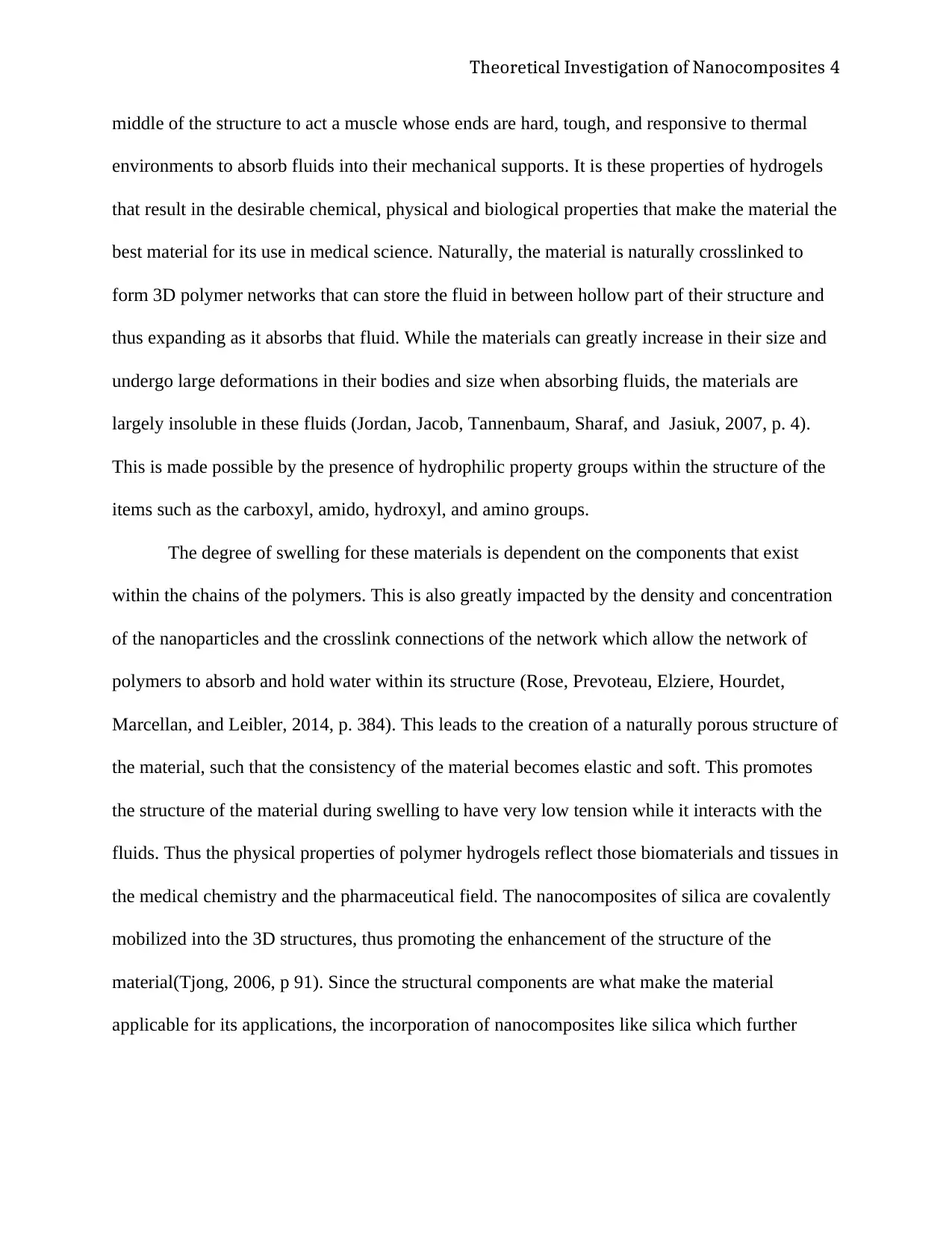
Theoretical Investigation of Nanocomposites 4
middle of the structure to act a muscle whose ends are hard, tough, and responsive to thermal
environments to absorb fluids into their mechanical supports. It is these properties of hydrogels
that result in the desirable chemical, physical and biological properties that make the material the
best material for its use in medical science. Naturally, the material is naturally crosslinked to
form 3D polymer networks that can store the fluid in between hollow part of their structure and
thus expanding as it absorbs that fluid. While the materials can greatly increase in their size and
undergo large deformations in their bodies and size when absorbing fluids, the materials are
largely insoluble in these fluids (Jordan, Jacob, Tannenbaum, Sharaf, and Jasiuk, 2007, p. 4).
This is made possible by the presence of hydrophilic property groups within the structure of the
items such as the carboxyl, amido, hydroxyl, and amino groups.
The degree of swelling for these materials is dependent on the components that exist
within the chains of the polymers. This is also greatly impacted by the density and concentration
of the nanoparticles and the crosslink connections of the network which allow the network of
polymers to absorb and hold water within its structure (Rose, Prevoteau, Elziere, Hourdet,
Marcellan, and Leibler, 2014, p. 384). This leads to the creation of a naturally porous structure of
the material, such that the consistency of the material becomes elastic and soft. This promotes
the structure of the material during swelling to have very low tension while it interacts with the
fluids. Thus the physical properties of polymer hydrogels reflect those biomaterials and tissues in
the medical chemistry and the pharmaceutical field. The nanocomposites of silica are covalently
mobilized into the 3D structures, thus promoting the enhancement of the structure of the
material(Tjong, 2006, p 91). Since the structural components are what make the material
applicable for its applications, the incorporation of nanocomposites like silica which further
middle of the structure to act a muscle whose ends are hard, tough, and responsive to thermal
environments to absorb fluids into their mechanical supports. It is these properties of hydrogels
that result in the desirable chemical, physical and biological properties that make the material the
best material for its use in medical science. Naturally, the material is naturally crosslinked to
form 3D polymer networks that can store the fluid in between hollow part of their structure and
thus expanding as it absorbs that fluid. While the materials can greatly increase in their size and
undergo large deformations in their bodies and size when absorbing fluids, the materials are
largely insoluble in these fluids (Jordan, Jacob, Tannenbaum, Sharaf, and Jasiuk, 2007, p. 4).
This is made possible by the presence of hydrophilic property groups within the structure of the
items such as the carboxyl, amido, hydroxyl, and amino groups.
The degree of swelling for these materials is dependent on the components that exist
within the chains of the polymers. This is also greatly impacted by the density and concentration
of the nanoparticles and the crosslink connections of the network which allow the network of
polymers to absorb and hold water within its structure (Rose, Prevoteau, Elziere, Hourdet,
Marcellan, and Leibler, 2014, p. 384). This leads to the creation of a naturally porous structure of
the material, such that the consistency of the material becomes elastic and soft. This promotes
the structure of the material during swelling to have very low tension while it interacts with the
fluids. Thus the physical properties of polymer hydrogels reflect those biomaterials and tissues in
the medical chemistry and the pharmaceutical field. The nanocomposites of silica are covalently
mobilized into the 3D structures, thus promoting the enhancement of the structure of the
material(Tjong, 2006, p 91). Since the structural components are what make the material
applicable for its applications, the incorporation of nanocomposites like silica which further
Paraphrase This Document
Need a fresh take? Get an instant paraphrase of this document with our AI Paraphraser
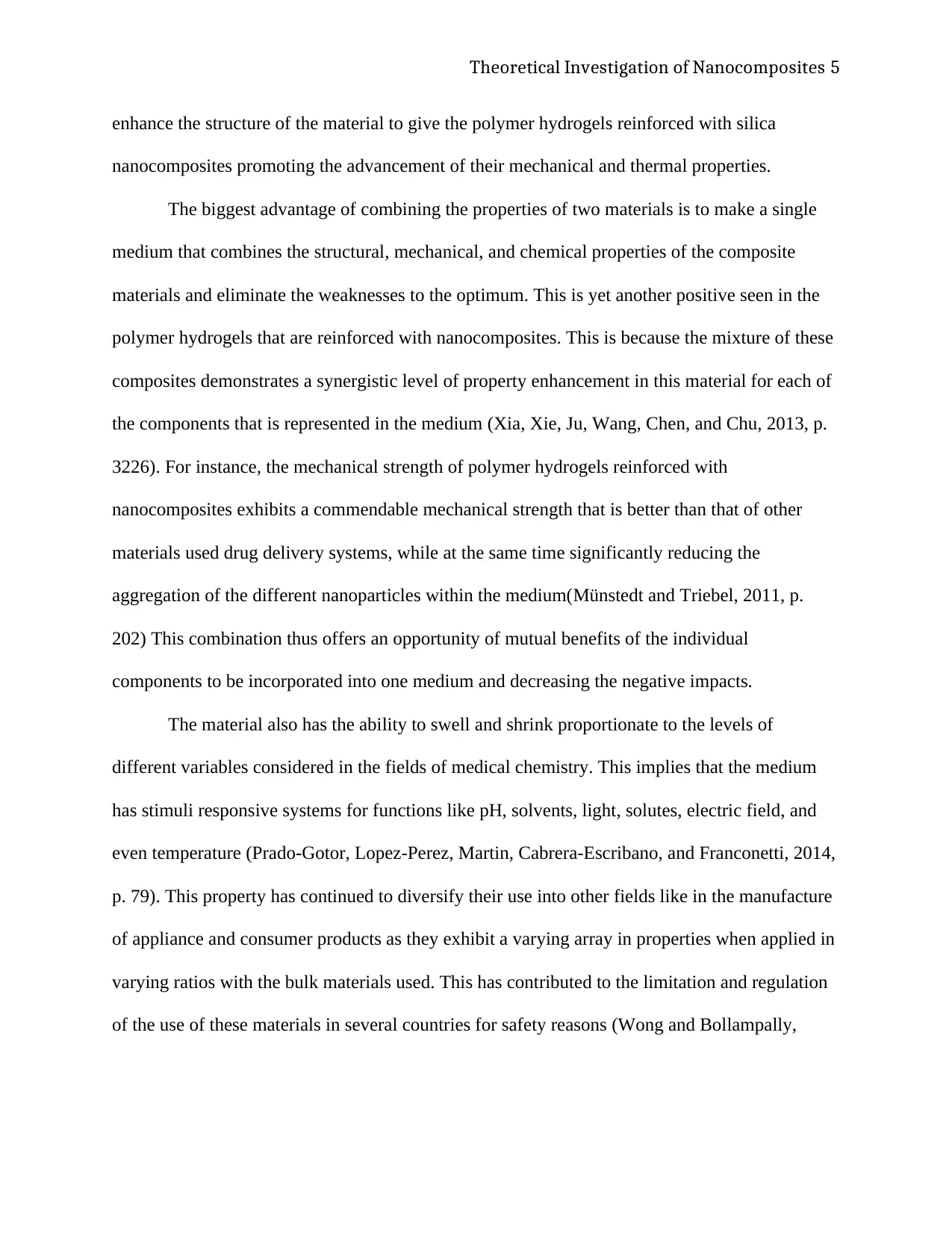
Theoretical Investigation of Nanocomposites 5
enhance the structure of the material to give the polymer hydrogels reinforced with silica
nanocomposites promoting the advancement of their mechanical and thermal properties.
The biggest advantage of combining the properties of two materials is to make a single
medium that combines the structural, mechanical, and chemical properties of the composite
materials and eliminate the weaknesses to the optimum. This is yet another positive seen in the
polymer hydrogels that are reinforced with nanocomposites. This is because the mixture of these
composites demonstrates a synergistic level of property enhancement in this material for each of
the components that is represented in the medium (Xia, Xie, Ju, Wang, Chen, and Chu, 2013, p.
3226). For instance, the mechanical strength of polymer hydrogels reinforced with
nanocomposites exhibits a commendable mechanical strength that is better than that of other
materials used drug delivery systems, while at the same time significantly reducing the
aggregation of the different nanoparticles within the medium(Münstedt and Triebel, 2011, p.
202) This combination thus offers an opportunity of mutual benefits of the individual
components to be incorporated into one medium and decreasing the negative impacts.
The material also has the ability to swell and shrink proportionate to the levels of
different variables considered in the fields of medical chemistry. This implies that the medium
has stimuli responsive systems for functions like pH, solvents, light, solutes, electric field, and
even temperature (Prado-Gotor, Lopez-Perez, Martin, Cabrera-Escribano, and Franconetti, 2014,
p. 79). This property has continued to diversify their use into other fields like in the manufacture
of appliance and consumer products as they exhibit a varying array in properties when applied in
varying ratios with the bulk materials used. This has contributed to the limitation and regulation
of the use of these materials in several countries for safety reasons (Wong and Bollampally,
enhance the structure of the material to give the polymer hydrogels reinforced with silica
nanocomposites promoting the advancement of their mechanical and thermal properties.
The biggest advantage of combining the properties of two materials is to make a single
medium that combines the structural, mechanical, and chemical properties of the composite
materials and eliminate the weaknesses to the optimum. This is yet another positive seen in the
polymer hydrogels that are reinforced with nanocomposites. This is because the mixture of these
composites demonstrates a synergistic level of property enhancement in this material for each of
the components that is represented in the medium (Xia, Xie, Ju, Wang, Chen, and Chu, 2013, p.
3226). For instance, the mechanical strength of polymer hydrogels reinforced with
nanocomposites exhibits a commendable mechanical strength that is better than that of other
materials used drug delivery systems, while at the same time significantly reducing the
aggregation of the different nanoparticles within the medium(Münstedt and Triebel, 2011, p.
202) This combination thus offers an opportunity of mutual benefits of the individual
components to be incorporated into one medium and decreasing the negative impacts.
The material also has the ability to swell and shrink proportionate to the levels of
different variables considered in the fields of medical chemistry. This implies that the medium
has stimuli responsive systems for functions like pH, solvents, light, solutes, electric field, and
even temperature (Prado-Gotor, Lopez-Perez, Martin, Cabrera-Escribano, and Franconetti, 2014,
p. 79). This property has continued to diversify their use into other fields like in the manufacture
of appliance and consumer products as they exhibit a varying array in properties when applied in
varying ratios with the bulk materials used. This has contributed to the limitation and regulation
of the use of these materials in several countries for safety reasons (Wong and Bollampally,
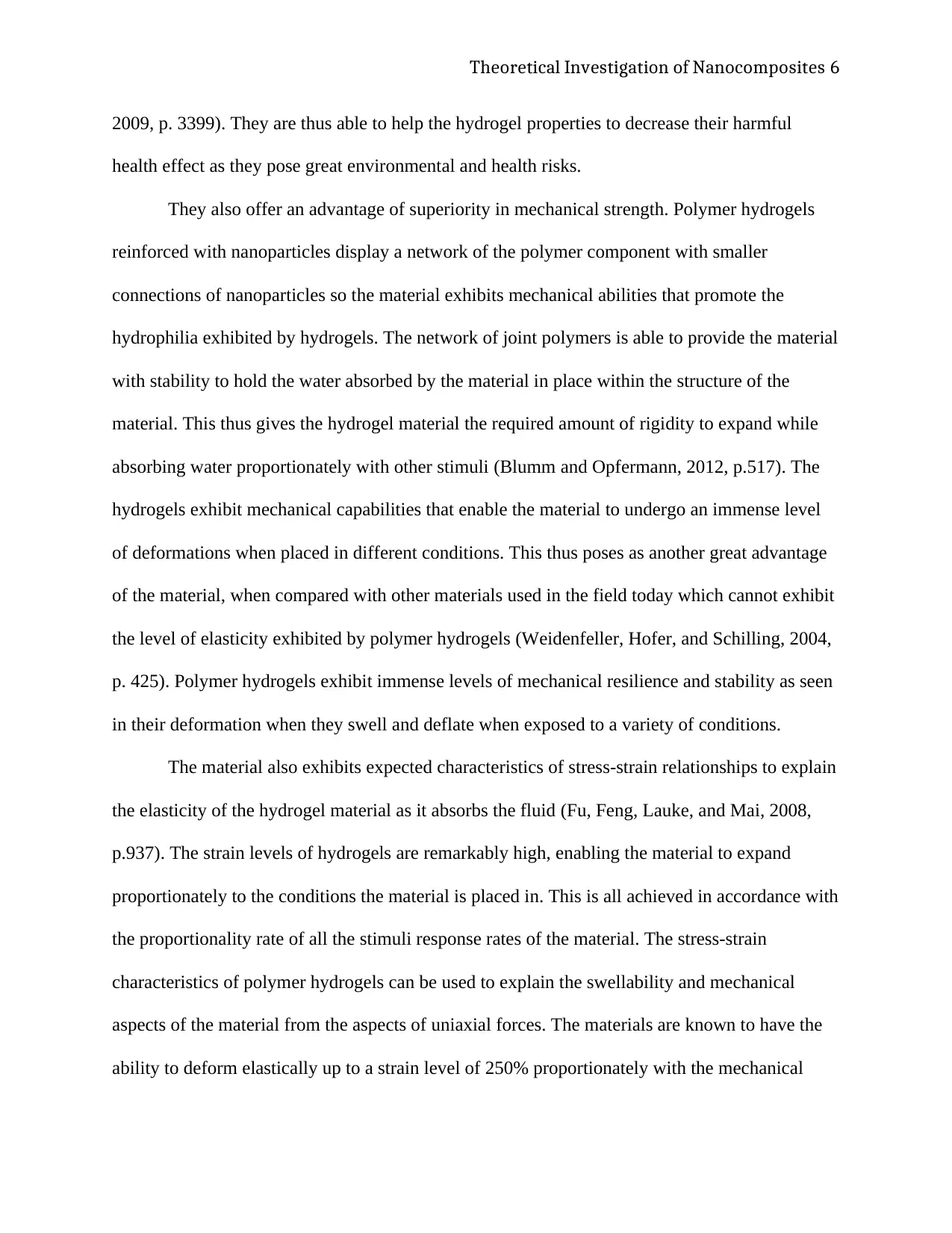
Theoretical Investigation of Nanocomposites 6
2009, p. 3399). They are thus able to help the hydrogel properties to decrease their harmful
health effect as they pose great environmental and health risks.
They also offer an advantage of superiority in mechanical strength. Polymer hydrogels
reinforced with nanoparticles display a network of the polymer component with smaller
connections of nanoparticles so the material exhibits mechanical abilities that promote the
hydrophilia exhibited by hydrogels. The network of joint polymers is able to provide the material
with stability to hold the water absorbed by the material in place within the structure of the
material. This thus gives the hydrogel material the required amount of rigidity to expand while
absorbing water proportionately with other stimuli (Blumm and Opfermann, 2012, p.517). The
hydrogels exhibit mechanical capabilities that enable the material to undergo an immense level
of deformations when placed in different conditions. This thus poses as another great advantage
of the material, when compared with other materials used in the field today which cannot exhibit
the level of elasticity exhibited by polymer hydrogels (Weidenfeller, Hofer, and Schilling, 2004,
p. 425). Polymer hydrogels exhibit immense levels of mechanical resilience and stability as seen
in their deformation when they swell and deflate when exposed to a variety of conditions.
The material also exhibits expected characteristics of stress-strain relationships to explain
the elasticity of the hydrogel material as it absorbs the fluid (Fu, Feng, Lauke, and Mai, 2008,
p.937). The strain levels of hydrogels are remarkably high, enabling the material to expand
proportionately to the conditions the material is placed in. This is all achieved in accordance with
the proportionality rate of all the stimuli response rates of the material. The stress-strain
characteristics of polymer hydrogels can be used to explain the swellability and mechanical
aspects of the material from the aspects of uniaxial forces. The materials are known to have the
ability to deform elastically up to a strain level of 250% proportionately with the mechanical
2009, p. 3399). They are thus able to help the hydrogel properties to decrease their harmful
health effect as they pose great environmental and health risks.
They also offer an advantage of superiority in mechanical strength. Polymer hydrogels
reinforced with nanoparticles display a network of the polymer component with smaller
connections of nanoparticles so the material exhibits mechanical abilities that promote the
hydrophilia exhibited by hydrogels. The network of joint polymers is able to provide the material
with stability to hold the water absorbed by the material in place within the structure of the
material. This thus gives the hydrogel material the required amount of rigidity to expand while
absorbing water proportionately with other stimuli (Blumm and Opfermann, 2012, p.517). The
hydrogels exhibit mechanical capabilities that enable the material to undergo an immense level
of deformations when placed in different conditions. This thus poses as another great advantage
of the material, when compared with other materials used in the field today which cannot exhibit
the level of elasticity exhibited by polymer hydrogels (Weidenfeller, Hofer, and Schilling, 2004,
p. 425). Polymer hydrogels exhibit immense levels of mechanical resilience and stability as seen
in their deformation when they swell and deflate when exposed to a variety of conditions.
The material also exhibits expected characteristics of stress-strain relationships to explain
the elasticity of the hydrogel material as it absorbs the fluid (Fu, Feng, Lauke, and Mai, 2008,
p.937). The strain levels of hydrogels are remarkably high, enabling the material to expand
proportionately to the conditions the material is placed in. This is all achieved in accordance with
the proportionality rate of all the stimuli response rates of the material. The stress-strain
characteristics of polymer hydrogels can be used to explain the swellability and mechanical
aspects of the material from the aspects of uniaxial forces. The materials are known to have the
ability to deform elastically up to a strain level of 250% proportionately with the mechanical
⊘ This is a preview!⊘
Do you want full access?
Subscribe today to unlock all pages.

Trusted by 1+ million students worldwide
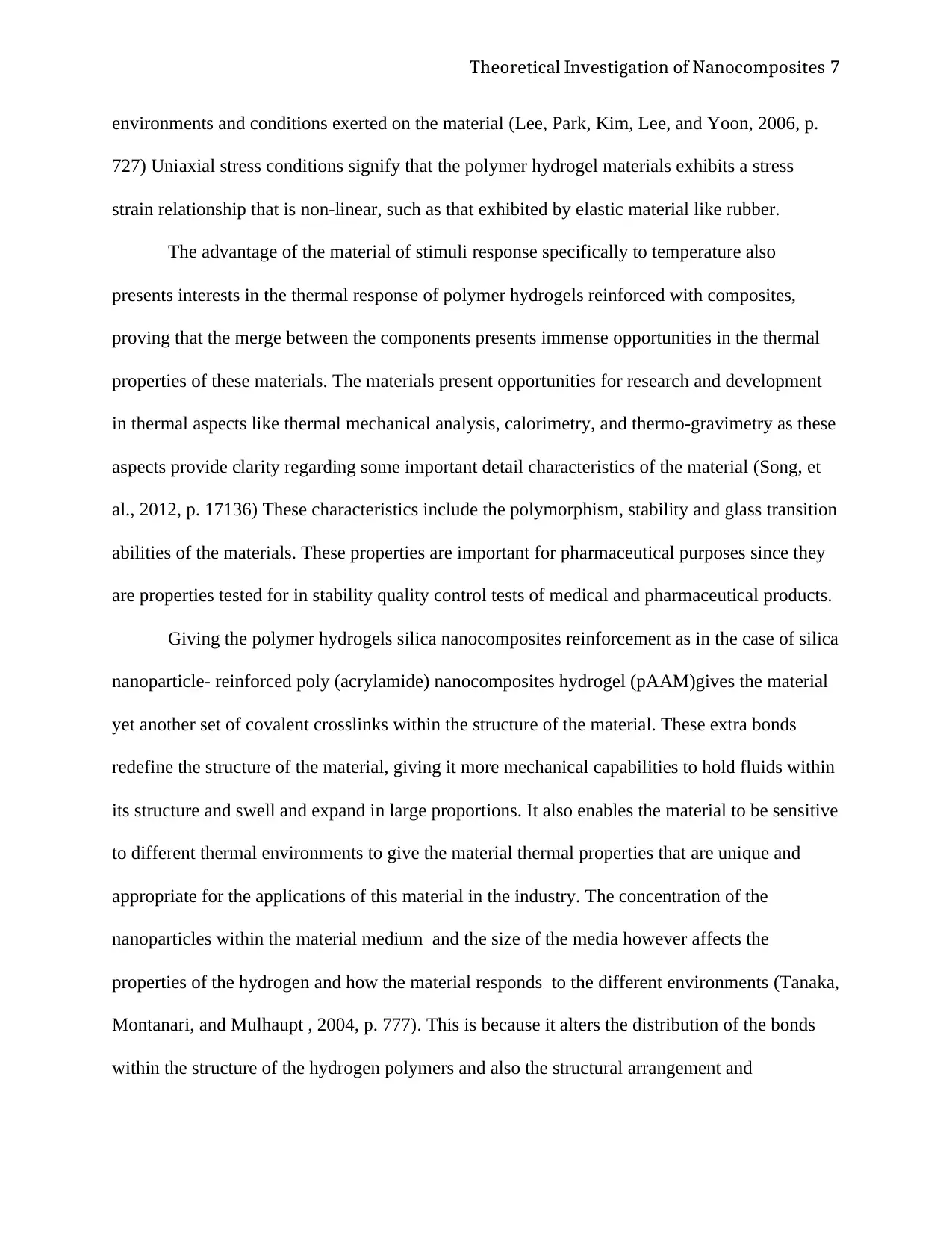
Theoretical Investigation of Nanocomposites 7
environments and conditions exerted on the material (Lee, Park, Kim, Lee, and Yoon, 2006, p.
727) Uniaxial stress conditions signify that the polymer hydrogel materials exhibits a stress
strain relationship that is non-linear, such as that exhibited by elastic material like rubber.
The advantage of the material of stimuli response specifically to temperature also
presents interests in the thermal response of polymer hydrogels reinforced with composites,
proving that the merge between the components presents immense opportunities in the thermal
properties of these materials. The materials present opportunities for research and development
in thermal aspects like thermal mechanical analysis, calorimetry, and thermo-gravimetry as these
aspects provide clarity regarding some important detail characteristics of the material (Song, et
al., 2012, p. 17136) These characteristics include the polymorphism, stability and glass transition
abilities of the materials. These properties are important for pharmaceutical purposes since they
are properties tested for in stability quality control tests of medical and pharmaceutical products.
Giving the polymer hydrogels silica nanocomposites reinforcement as in the case of silica
nanoparticle- reinforced poly (acrylamide) nanocomposites hydrogel (pAAM)gives the material
yet another set of covalent crosslinks within the structure of the material. These extra bonds
redefine the structure of the material, giving it more mechanical capabilities to hold fluids within
its structure and swell and expand in large proportions. It also enables the material to be sensitive
to different thermal environments to give the material thermal properties that are unique and
appropriate for the applications of this material in the industry. The concentration of the
nanoparticles within the material medium and the size of the media however affects the
properties of the hydrogen and how the material responds to the different environments (Tanaka,
Montanari, and Mulhaupt , 2004, p. 777). This is because it alters the distribution of the bonds
within the structure of the hydrogen polymers and also the structural arrangement and
environments and conditions exerted on the material (Lee, Park, Kim, Lee, and Yoon, 2006, p.
727) Uniaxial stress conditions signify that the polymer hydrogel materials exhibits a stress
strain relationship that is non-linear, such as that exhibited by elastic material like rubber.
The advantage of the material of stimuli response specifically to temperature also
presents interests in the thermal response of polymer hydrogels reinforced with composites,
proving that the merge between the components presents immense opportunities in the thermal
properties of these materials. The materials present opportunities for research and development
in thermal aspects like thermal mechanical analysis, calorimetry, and thermo-gravimetry as these
aspects provide clarity regarding some important detail characteristics of the material (Song, et
al., 2012, p. 17136) These characteristics include the polymorphism, stability and glass transition
abilities of the materials. These properties are important for pharmaceutical purposes since they
are properties tested for in stability quality control tests of medical and pharmaceutical products.
Giving the polymer hydrogels silica nanocomposites reinforcement as in the case of silica
nanoparticle- reinforced poly (acrylamide) nanocomposites hydrogel (pAAM)gives the material
yet another set of covalent crosslinks within the structure of the material. These extra bonds
redefine the structure of the material, giving it more mechanical capabilities to hold fluids within
its structure and swell and expand in large proportions. It also enables the material to be sensitive
to different thermal environments to give the material thermal properties that are unique and
appropriate for the applications of this material in the industry. The concentration of the
nanoparticles within the material medium and the size of the media however affects the
properties of the hydrogen and how the material responds to the different environments (Tanaka,
Montanari, and Mulhaupt , 2004, p. 777). This is because it alters the distribution of the bonds
within the structure of the hydrogen polymers and also the structural arrangement and
Paraphrase This Document
Need a fresh take? Get an instant paraphrase of this document with our AI Paraphraser
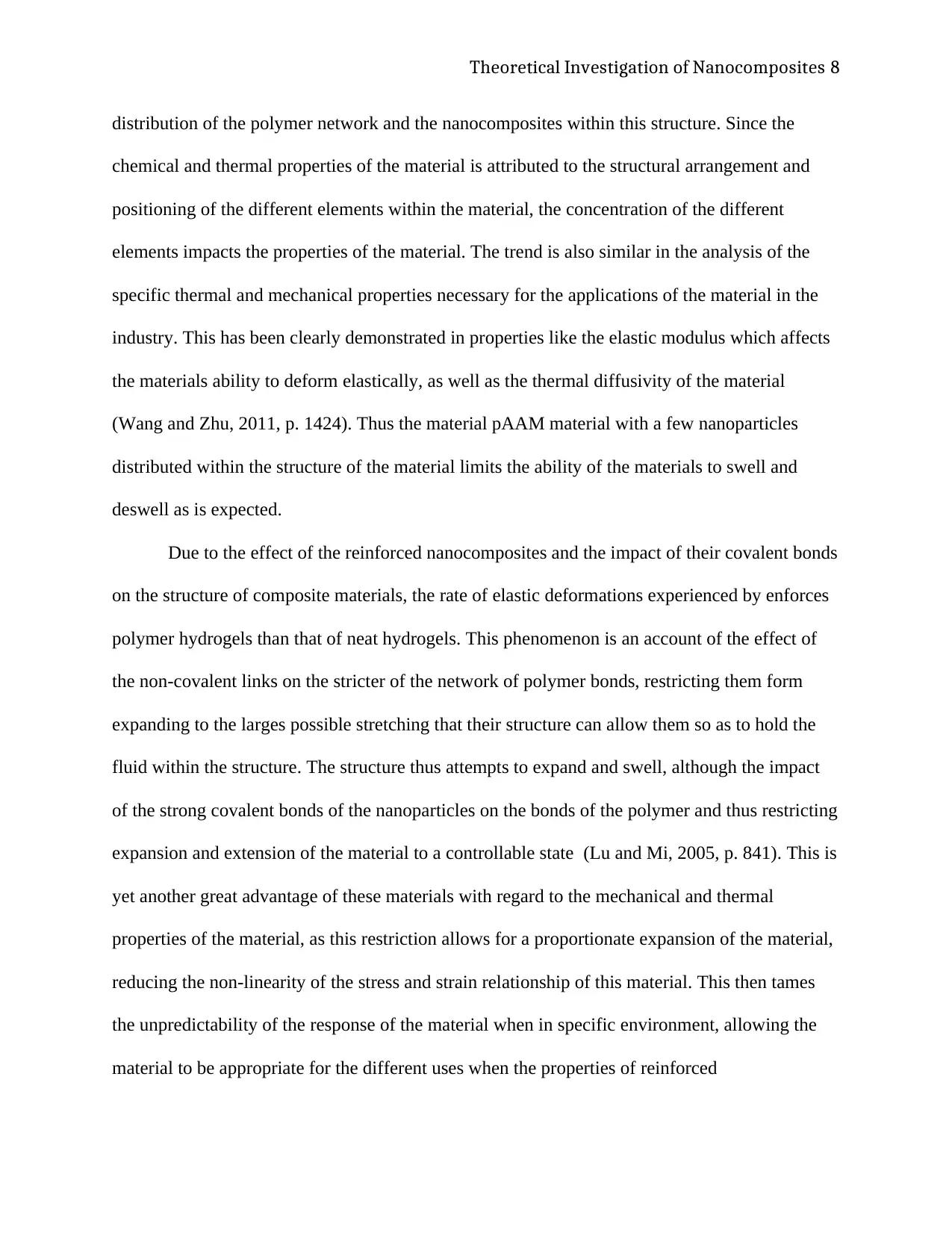
Theoretical Investigation of Nanocomposites 8
distribution of the polymer network and the nanocomposites within this structure. Since the
chemical and thermal properties of the material is attributed to the structural arrangement and
positioning of the different elements within the material, the concentration of the different
elements impacts the properties of the material. The trend is also similar in the analysis of the
specific thermal and mechanical properties necessary for the applications of the material in the
industry. This has been clearly demonstrated in properties like the elastic modulus which affects
the materials ability to deform elastically, as well as the thermal diffusivity of the material
(Wang and Zhu, 2011, p. 1424). Thus the material pAAM material with a few nanoparticles
distributed within the structure of the material limits the ability of the materials to swell and
deswell as is expected.
Due to the effect of the reinforced nanocomposites and the impact of their covalent bonds
on the structure of composite materials, the rate of elastic deformations experienced by enforces
polymer hydrogels than that of neat hydrogels. This phenomenon is an account of the effect of
the non-covalent links on the stricter of the network of polymer bonds, restricting them form
expanding to the larges possible stretching that their structure can allow them so as to hold the
fluid within the structure. The structure thus attempts to expand and swell, although the impact
of the strong covalent bonds of the nanoparticles on the bonds of the polymer and thus restricting
expansion and extension of the material to a controllable state (Lu and Mi, 2005, p. 841). This is
yet another great advantage of these materials with regard to the mechanical and thermal
properties of the material, as this restriction allows for a proportionate expansion of the material,
reducing the non-linearity of the stress and strain relationship of this material. This then tames
the unpredictability of the response of the material when in specific environment, allowing the
material to be appropriate for the different uses when the properties of reinforced
distribution of the polymer network and the nanocomposites within this structure. Since the
chemical and thermal properties of the material is attributed to the structural arrangement and
positioning of the different elements within the material, the concentration of the different
elements impacts the properties of the material. The trend is also similar in the analysis of the
specific thermal and mechanical properties necessary for the applications of the material in the
industry. This has been clearly demonstrated in properties like the elastic modulus which affects
the materials ability to deform elastically, as well as the thermal diffusivity of the material
(Wang and Zhu, 2011, p. 1424). Thus the material pAAM material with a few nanoparticles
distributed within the structure of the material limits the ability of the materials to swell and
deswell as is expected.
Due to the effect of the reinforced nanocomposites and the impact of their covalent bonds
on the structure of composite materials, the rate of elastic deformations experienced by enforces
polymer hydrogels than that of neat hydrogels. This phenomenon is an account of the effect of
the non-covalent links on the stricter of the network of polymer bonds, restricting them form
expanding to the larges possible stretching that their structure can allow them so as to hold the
fluid within the structure. The structure thus attempts to expand and swell, although the impact
of the strong covalent bonds of the nanoparticles on the bonds of the polymer and thus restricting
expansion and extension of the material to a controllable state (Lu and Mi, 2005, p. 841). This is
yet another great advantage of these materials with regard to the mechanical and thermal
properties of the material, as this restriction allows for a proportionate expansion of the material,
reducing the non-linearity of the stress and strain relationship of this material. This then tames
the unpredictability of the response of the material when in specific environment, allowing the
material to be appropriate for the different uses when the properties of reinforced
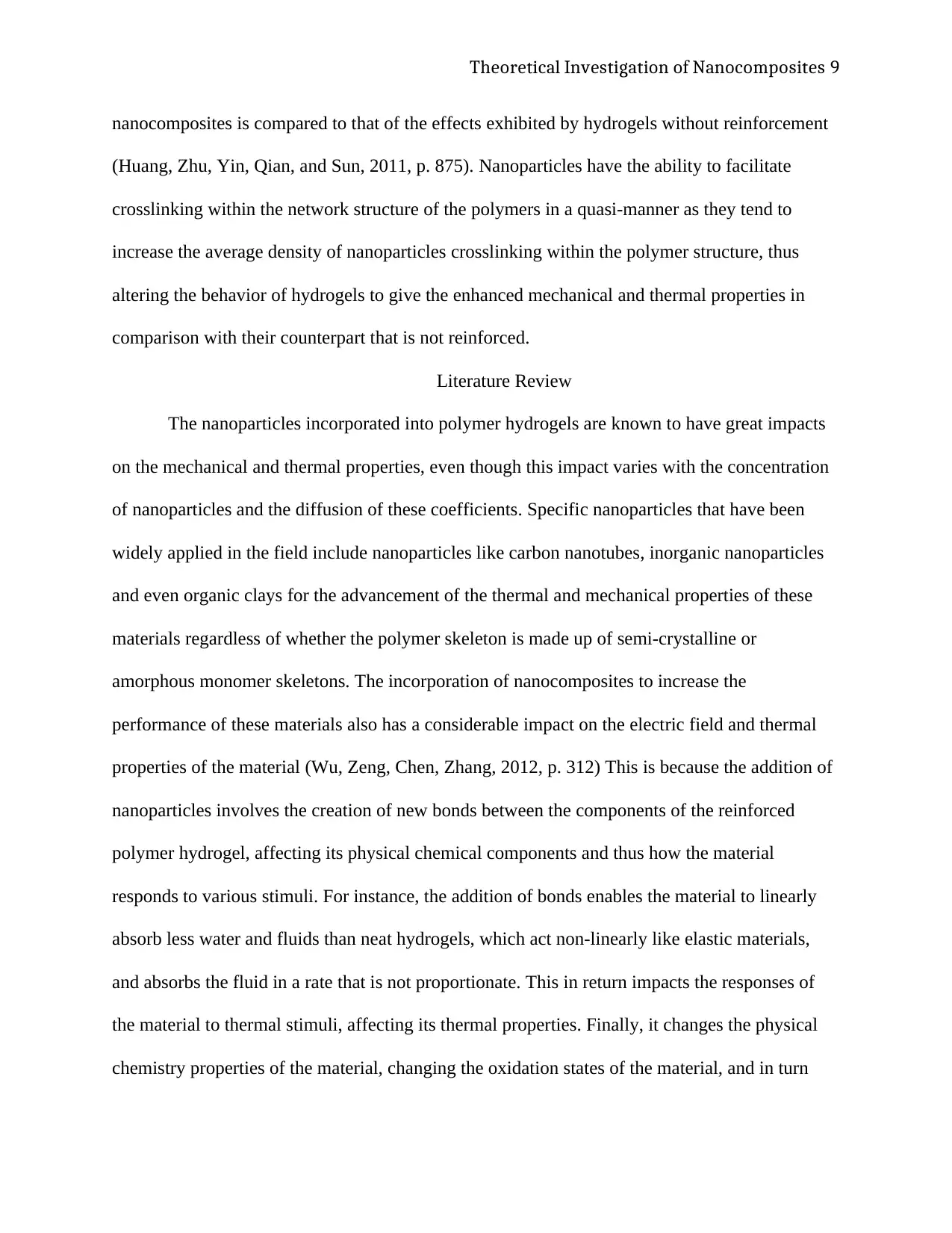
Theoretical Investigation of Nanocomposites 9
nanocomposites is compared to that of the effects exhibited by hydrogels without reinforcement
(Huang, Zhu, Yin, Qian, and Sun, 2011, p. 875). Nanoparticles have the ability to facilitate
crosslinking within the network structure of the polymers in a quasi-manner as they tend to
increase the average density of nanoparticles crosslinking within the polymer structure, thus
altering the behavior of hydrogels to give the enhanced mechanical and thermal properties in
comparison with their counterpart that is not reinforced.
Literature Review
The nanoparticles incorporated into polymer hydrogels are known to have great impacts
on the mechanical and thermal properties, even though this impact varies with the concentration
of nanoparticles and the diffusion of these coefficients. Specific nanoparticles that have been
widely applied in the field include nanoparticles like carbon nanotubes, inorganic nanoparticles
and even organic clays for the advancement of the thermal and mechanical properties of these
materials regardless of whether the polymer skeleton is made up of semi-crystalline or
amorphous monomer skeletons. The incorporation of nanocomposites to increase the
performance of these materials also has a considerable impact on the electric field and thermal
properties of the material (Wu, Zeng, Chen, Zhang, 2012, p. 312) This is because the addition of
nanoparticles involves the creation of new bonds between the components of the reinforced
polymer hydrogel, affecting its physical chemical components and thus how the material
responds to various stimuli. For instance, the addition of bonds enables the material to linearly
absorb less water and fluids than neat hydrogels, which act non-linearly like elastic materials,
and absorbs the fluid in a rate that is not proportionate. This in return impacts the responses of
the material to thermal stimuli, affecting its thermal properties. Finally, it changes the physical
chemistry properties of the material, changing the oxidation states of the material, and in turn
nanocomposites is compared to that of the effects exhibited by hydrogels without reinforcement
(Huang, Zhu, Yin, Qian, and Sun, 2011, p. 875). Nanoparticles have the ability to facilitate
crosslinking within the network structure of the polymers in a quasi-manner as they tend to
increase the average density of nanoparticles crosslinking within the polymer structure, thus
altering the behavior of hydrogels to give the enhanced mechanical and thermal properties in
comparison with their counterpart that is not reinforced.
Literature Review
The nanoparticles incorporated into polymer hydrogels are known to have great impacts
on the mechanical and thermal properties, even though this impact varies with the concentration
of nanoparticles and the diffusion of these coefficients. Specific nanoparticles that have been
widely applied in the field include nanoparticles like carbon nanotubes, inorganic nanoparticles
and even organic clays for the advancement of the thermal and mechanical properties of these
materials regardless of whether the polymer skeleton is made up of semi-crystalline or
amorphous monomer skeletons. The incorporation of nanocomposites to increase the
performance of these materials also has a considerable impact on the electric field and thermal
properties of the material (Wu, Zeng, Chen, Zhang, 2012, p. 312) This is because the addition of
nanoparticles involves the creation of new bonds between the components of the reinforced
polymer hydrogel, affecting its physical chemical components and thus how the material
responds to various stimuli. For instance, the addition of bonds enables the material to linearly
absorb less water and fluids than neat hydrogels, which act non-linearly like elastic materials,
and absorbs the fluid in a rate that is not proportionate. This in return impacts the responses of
the material to thermal stimuli, affecting its thermal properties. Finally, it changes the physical
chemistry properties of the material, changing the oxidation states of the material, and in turn
⊘ This is a preview!⊘
Do you want full access?
Subscribe today to unlock all pages.

Trusted by 1+ million students worldwide
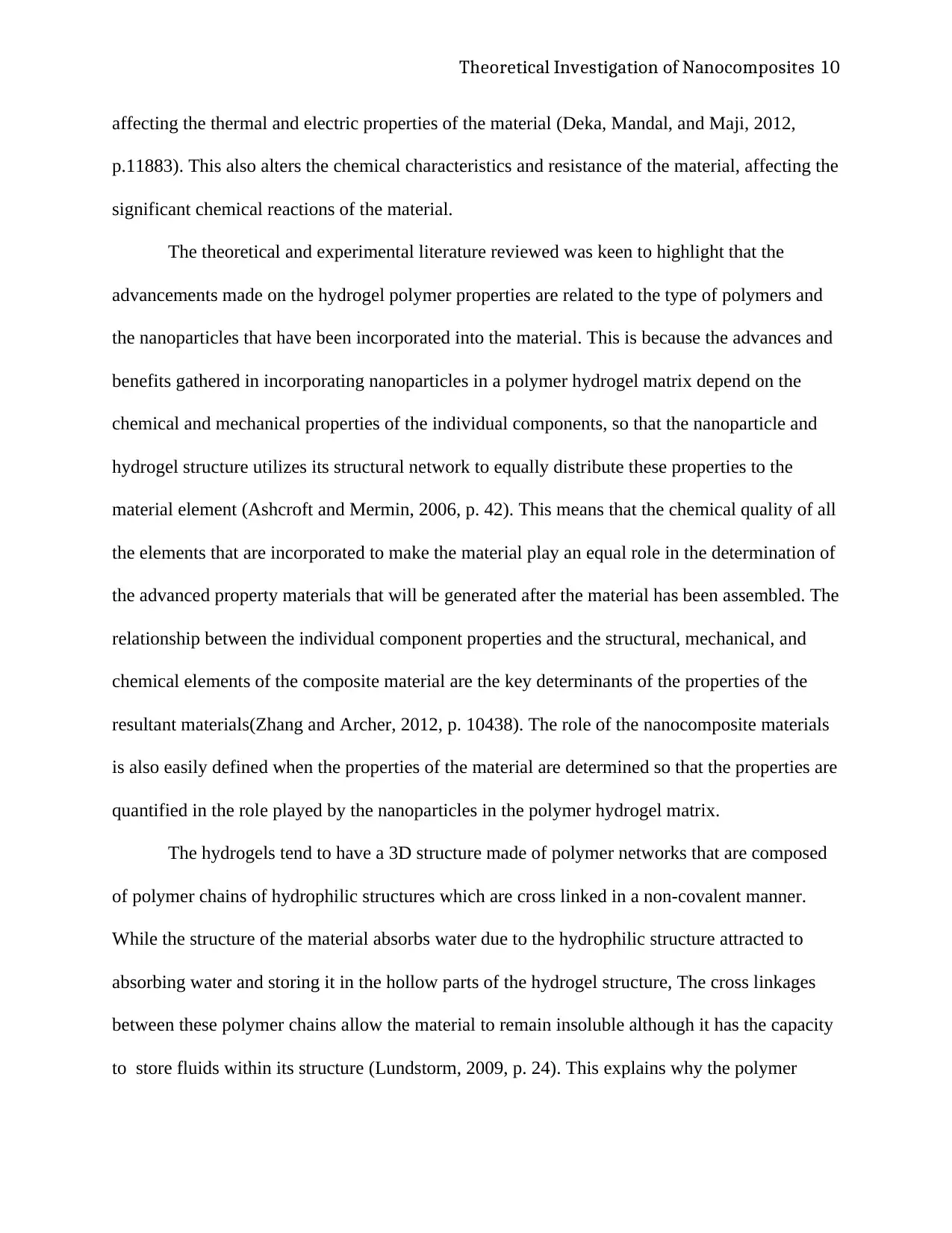
Theoretical Investigation of Nanocomposites 10
affecting the thermal and electric properties of the material (Deka, Mandal, and Maji, 2012,
p.11883). This also alters the chemical characteristics and resistance of the material, affecting the
significant chemical reactions of the material.
The theoretical and experimental literature reviewed was keen to highlight that the
advancements made on the hydrogel polymer properties are related to the type of polymers and
the nanoparticles that have been incorporated into the material. This is because the advances and
benefits gathered in incorporating nanoparticles in a polymer hydrogel matrix depend on the
chemical and mechanical properties of the individual components, so that the nanoparticle and
hydrogel structure utilizes its structural network to equally distribute these properties to the
material element (Ashcroft and Mermin, 2006, p. 42). This means that the chemical quality of all
the elements that are incorporated to make the material play an equal role in the determination of
the advanced property materials that will be generated after the material has been assembled. The
relationship between the individual component properties and the structural, mechanical, and
chemical elements of the composite material are the key determinants of the properties of the
resultant materials(Zhang and Archer, 2012, p. 10438). The role of the nanocomposite materials
is also easily defined when the properties of the material are determined so that the properties are
quantified in the role played by the nanoparticles in the polymer hydrogel matrix.
The hydrogels tend to have a 3D structure made of polymer networks that are composed
of polymer chains of hydrophilic structures which are cross linked in a non-covalent manner.
While the structure of the material absorbs water due to the hydrophilic structure attracted to
absorbing water and storing it in the hollow parts of the hydrogel structure, The cross linkages
between these polymer chains allow the material to remain insoluble although it has the capacity
to store fluids within its structure (Lundstorm, 2009, p. 24). This explains why the polymer
affecting the thermal and electric properties of the material (Deka, Mandal, and Maji, 2012,
p.11883). This also alters the chemical characteristics and resistance of the material, affecting the
significant chemical reactions of the material.
The theoretical and experimental literature reviewed was keen to highlight that the
advancements made on the hydrogel polymer properties are related to the type of polymers and
the nanoparticles that have been incorporated into the material. This is because the advances and
benefits gathered in incorporating nanoparticles in a polymer hydrogel matrix depend on the
chemical and mechanical properties of the individual components, so that the nanoparticle and
hydrogel structure utilizes its structural network to equally distribute these properties to the
material element (Ashcroft and Mermin, 2006, p. 42). This means that the chemical quality of all
the elements that are incorporated to make the material play an equal role in the determination of
the advanced property materials that will be generated after the material has been assembled. The
relationship between the individual component properties and the structural, mechanical, and
chemical elements of the composite material are the key determinants of the properties of the
resultant materials(Zhang and Archer, 2012, p. 10438). The role of the nanocomposite materials
is also easily defined when the properties of the material are determined so that the properties are
quantified in the role played by the nanoparticles in the polymer hydrogel matrix.
The hydrogels tend to have a 3D structure made of polymer networks that are composed
of polymer chains of hydrophilic structures which are cross linked in a non-covalent manner.
While the structure of the material absorbs water due to the hydrophilic structure attracted to
absorbing water and storing it in the hollow parts of the hydrogel structure, The cross linkages
between these polymer chains allow the material to remain insoluble although it has the capacity
to store fluids within its structure (Lundstorm, 2009, p. 24). This explains why the polymer
Paraphrase This Document
Need a fresh take? Get an instant paraphrase of this document with our AI Paraphraser
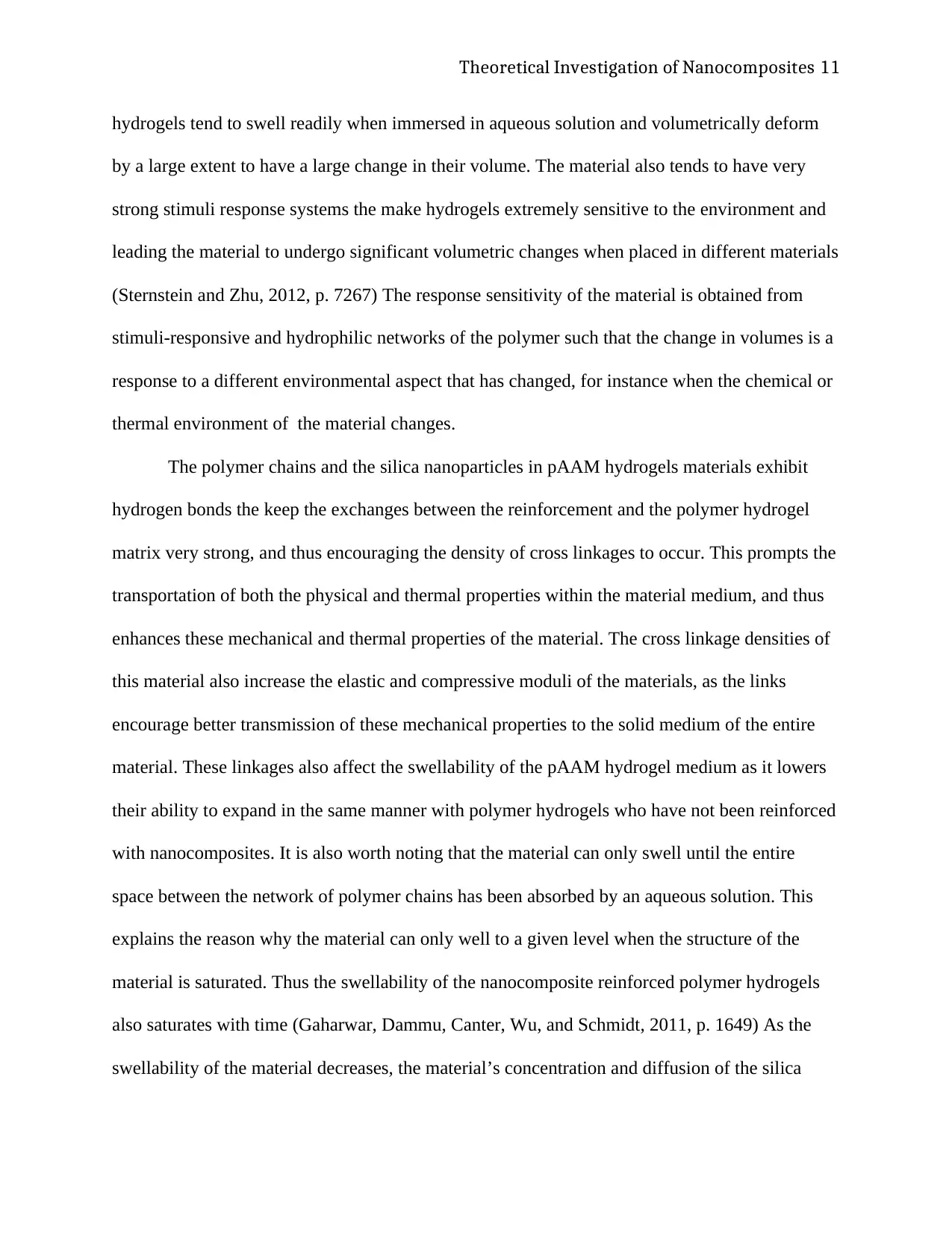
Theoretical Investigation of Nanocomposites 11
hydrogels tend to swell readily when immersed in aqueous solution and volumetrically deform
by a large extent to have a large change in their volume. The material also tends to have very
strong stimuli response systems the make hydrogels extremely sensitive to the environment and
leading the material to undergo significant volumetric changes when placed in different materials
(Sternstein and Zhu, 2012, p. 7267) The response sensitivity of the material is obtained from
stimuli-responsive and hydrophilic networks of the polymer such that the change in volumes is a
response to a different environmental aspect that has changed, for instance when the chemical or
thermal environment of the material changes.
The polymer chains and the silica nanoparticles in pAAM hydrogels materials exhibit
hydrogen bonds the keep the exchanges between the reinforcement and the polymer hydrogel
matrix very strong, and thus encouraging the density of cross linkages to occur. This prompts the
transportation of both the physical and thermal properties within the material medium, and thus
enhances these mechanical and thermal properties of the material. The cross linkage densities of
this material also increase the elastic and compressive moduli of the materials, as the links
encourage better transmission of these mechanical properties to the solid medium of the entire
material. These linkages also affect the swellability of the pAAM hydrogel medium as it lowers
their ability to expand in the same manner with polymer hydrogels who have not been reinforced
with nanocomposites. It is also worth noting that the material can only swell until the entire
space between the network of polymer chains has been absorbed by an aqueous solution. This
explains the reason why the material can only well to a given level when the structure of the
material is saturated. Thus the swellability of the nanocomposite reinforced polymer hydrogels
also saturates with time (Gaharwar, Dammu, Canter, Wu, and Schmidt, 2011, p. 1649) As the
swellability of the material decreases, the material’s concentration and diffusion of the silica
hydrogels tend to swell readily when immersed in aqueous solution and volumetrically deform
by a large extent to have a large change in their volume. The material also tends to have very
strong stimuli response systems the make hydrogels extremely sensitive to the environment and
leading the material to undergo significant volumetric changes when placed in different materials
(Sternstein and Zhu, 2012, p. 7267) The response sensitivity of the material is obtained from
stimuli-responsive and hydrophilic networks of the polymer such that the change in volumes is a
response to a different environmental aspect that has changed, for instance when the chemical or
thermal environment of the material changes.
The polymer chains and the silica nanoparticles in pAAM hydrogels materials exhibit
hydrogen bonds the keep the exchanges between the reinforcement and the polymer hydrogel
matrix very strong, and thus encouraging the density of cross linkages to occur. This prompts the
transportation of both the physical and thermal properties within the material medium, and thus
enhances these mechanical and thermal properties of the material. The cross linkage densities of
this material also increase the elastic and compressive moduli of the materials, as the links
encourage better transmission of these mechanical properties to the solid medium of the entire
material. These linkages also affect the swellability of the pAAM hydrogel medium as it lowers
their ability to expand in the same manner with polymer hydrogels who have not been reinforced
with nanocomposites. It is also worth noting that the material can only swell until the entire
space between the network of polymer chains has been absorbed by an aqueous solution. This
explains the reason why the material can only well to a given level when the structure of the
material is saturated. Thus the swellability of the nanocomposite reinforced polymer hydrogels
also saturates with time (Gaharwar, Dammu, Canter, Wu, and Schmidt, 2011, p. 1649) As the
swellability of the material decreases, the material’s concentration and diffusion of the silica
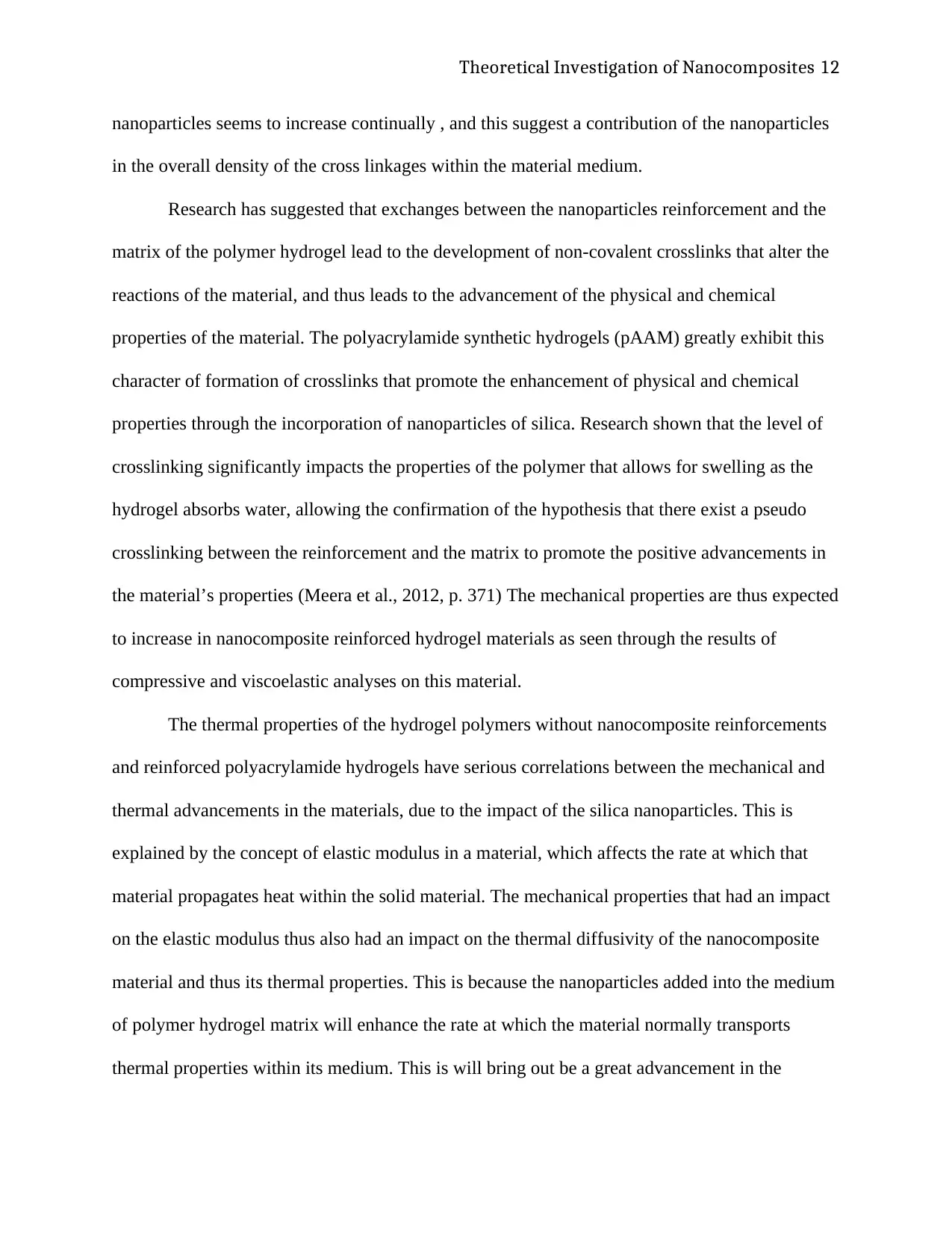
Theoretical Investigation of Nanocomposites 12
nanoparticles seems to increase continually , and this suggest a contribution of the nanoparticles
in the overall density of the cross linkages within the material medium.
Research has suggested that exchanges between the nanoparticles reinforcement and the
matrix of the polymer hydrogel lead to the development of non-covalent crosslinks that alter the
reactions of the material, and thus leads to the advancement of the physical and chemical
properties of the material. The polyacrylamide synthetic hydrogels (pAAM) greatly exhibit this
character of formation of crosslinks that promote the enhancement of physical and chemical
properties through the incorporation of nanoparticles of silica. Research shown that the level of
crosslinking significantly impacts the properties of the polymer that allows for swelling as the
hydrogel absorbs water, allowing the confirmation of the hypothesis that there exist a pseudo
crosslinking between the reinforcement and the matrix to promote the positive advancements in
the material’s properties (Meera et al., 2012, p. 371) The mechanical properties are thus expected
to increase in nanocomposite reinforced hydrogel materials as seen through the results of
compressive and viscoelastic analyses on this material.
The thermal properties of the hydrogel polymers without nanocomposite reinforcements
and reinforced polyacrylamide hydrogels have serious correlations between the mechanical and
thermal advancements in the materials, due to the impact of the silica nanoparticles. This is
explained by the concept of elastic modulus in a material, which affects the rate at which that
material propagates heat within the solid material. The mechanical properties that had an impact
on the elastic modulus thus also had an impact on the thermal diffusivity of the nanocomposite
material and thus its thermal properties. This is because the nanoparticles added into the medium
of polymer hydrogel matrix will enhance the rate at which the material normally transports
thermal properties within its medium. This is will bring out be a great advancement in the
nanoparticles seems to increase continually , and this suggest a contribution of the nanoparticles
in the overall density of the cross linkages within the material medium.
Research has suggested that exchanges between the nanoparticles reinforcement and the
matrix of the polymer hydrogel lead to the development of non-covalent crosslinks that alter the
reactions of the material, and thus leads to the advancement of the physical and chemical
properties of the material. The polyacrylamide synthetic hydrogels (pAAM) greatly exhibit this
character of formation of crosslinks that promote the enhancement of physical and chemical
properties through the incorporation of nanoparticles of silica. Research shown that the level of
crosslinking significantly impacts the properties of the polymer that allows for swelling as the
hydrogel absorbs water, allowing the confirmation of the hypothesis that there exist a pseudo
crosslinking between the reinforcement and the matrix to promote the positive advancements in
the material’s properties (Meera et al., 2012, p. 371) The mechanical properties are thus expected
to increase in nanocomposite reinforced hydrogel materials as seen through the results of
compressive and viscoelastic analyses on this material.
The thermal properties of the hydrogel polymers without nanocomposite reinforcements
and reinforced polyacrylamide hydrogels have serious correlations between the mechanical and
thermal advancements in the materials, due to the impact of the silica nanoparticles. This is
explained by the concept of elastic modulus in a material, which affects the rate at which that
material propagates heat within the solid material. The mechanical properties that had an impact
on the elastic modulus thus also had an impact on the thermal diffusivity of the nanocomposite
material and thus its thermal properties. This is because the nanoparticles added into the medium
of polymer hydrogel matrix will enhance the rate at which the material normally transports
thermal properties within its medium. This is will bring out be a great advancement in the
⊘ This is a preview!⊘
Do you want full access?
Subscribe today to unlock all pages.

Trusted by 1+ million students worldwide
1 out of 36
Your All-in-One AI-Powered Toolkit for Academic Success.
+13062052269
info@desklib.com
Available 24*7 on WhatsApp / Email
![[object Object]](/_next/static/media/star-bottom.7253800d.svg)
Unlock your academic potential
Copyright © 2020–2025 A2Z Services. All Rights Reserved. Developed and managed by ZUCOL.